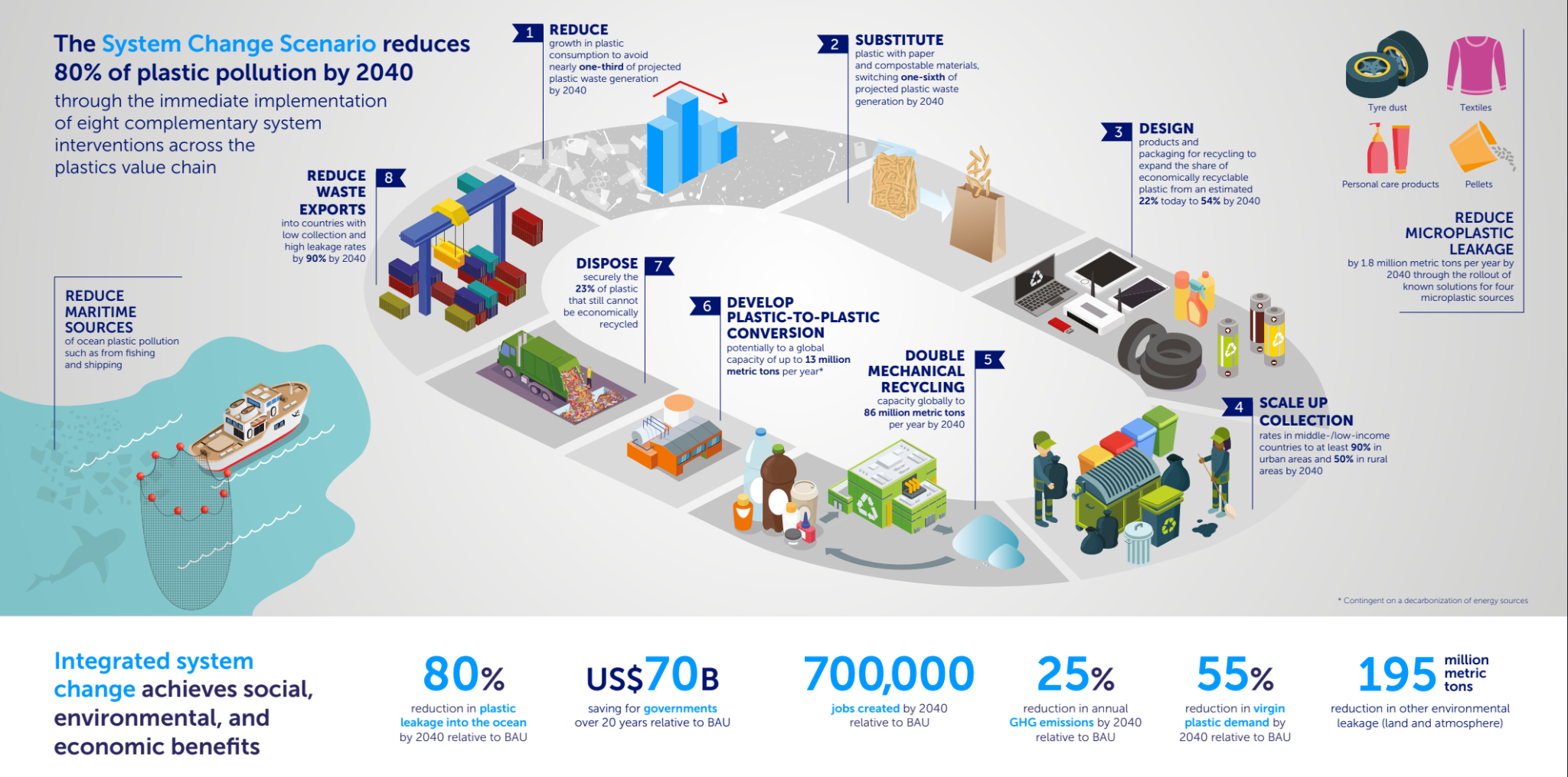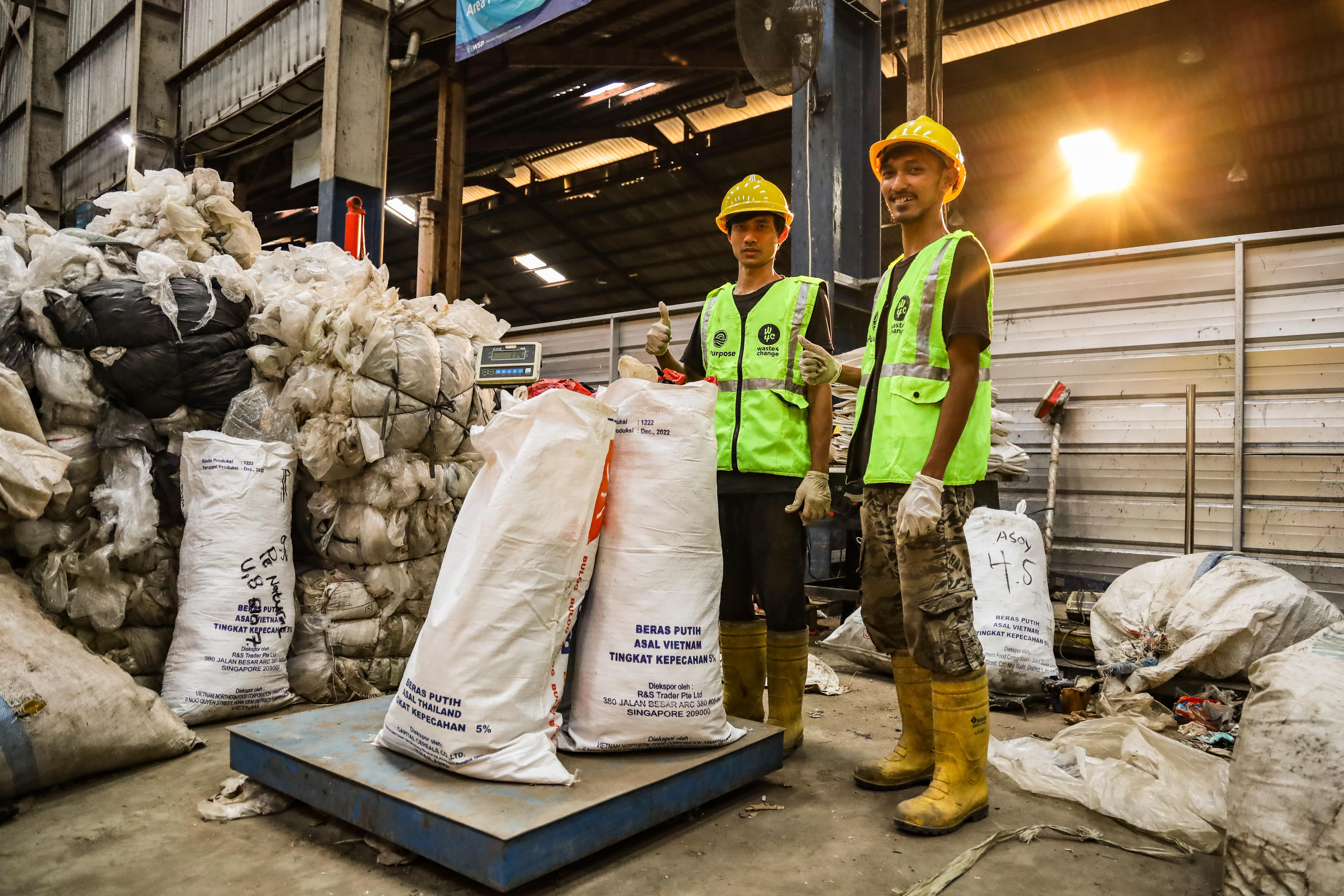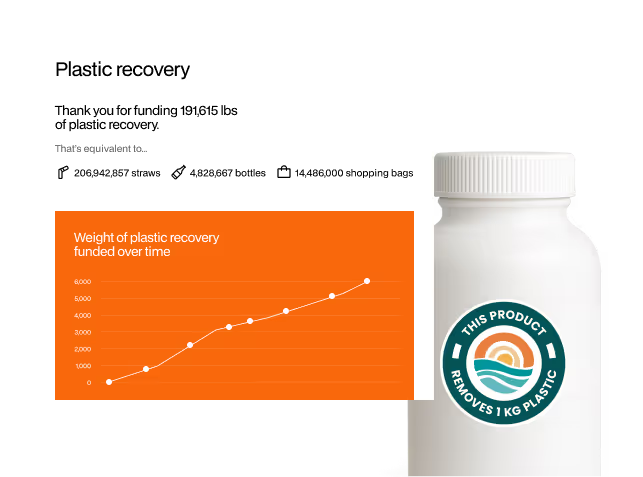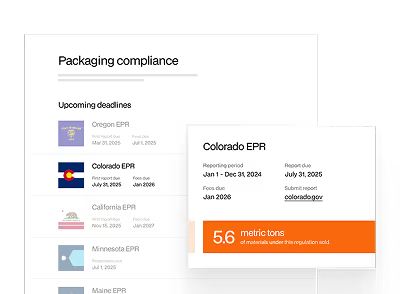The circular economy is the idea that products and materials should stay in use for as long as possible, through reduction, reuse, recycling, and recovery. Instead of a linear “take-make-waste” model, circular systems aim for a closed loop where waste becomes input for new production.
But the reality is stark: according to Breaking the Plastic Wave (Pew Charitable Trusts & Ellen MacArthur Foundation, 2020), plastic leakage into the environment is set to triple by 2040 if we continue on our current trajectory. The report shows that:
- Only recycling cannot scale fast enough to absorb the sheer growth of plastic demand.
- Only reduction fails to address the billions of tons of plastic already in circulation.
- Only reuse or bans are not sufficient in isolation.
No single solution can turn the tide. The greatest opportunity lies in systems change — connecting upstream design decisions, midstream collection systems, and downstream recovery infrastructure. That is why end-of-life management — recovering plastic waste that would otherwise leak into nature — is so essential. Without it, circularity remains incomplete.

This article explores Verified Plastic Recovery Units (VPRUs), a financing mechanism developed by rePurpose Global to fund critical parts of the waste management supply chain, and explains how they fit into broader sustainability strategies.
Quick Takeaway: VPRUs provide companies with a way to take tangible responsibility for plastic waste mitigation today, meet and investor expectations, support waste workers globally, and lay the groundwork for circular supply chains. They are not a replacement for reduction or redesign, but a bridge strategy that enables accountability while companies transform upstream systems.
What Are Verified Plastic Recovery Units?
A Verified Plastic Recovery Unit (VPRU) certifies that 1 kilogram of plastic waste has been recovered and responsibly processed, backed by independent third-party verification.
All rePurpose VPRUs are governed by the BASE Framework — a set of Global Impact Protocols that ensure recovery projects deliver environmental, economic, and social outcomes. You can read the full four-part series here:
The BASE framework is built on four pillars: Baseline, Additionality, Social impact, and Environmental integrity. Together, they ensure VPRUs go beyond plastic recovery and include multidimensional impact.
- Baseline: Proof that recovery wouldn’t have happened without intervention.
- Additionality: Funding flows to low-value plastics and regions without infrastructure.
- Social impact: Worker protections, fair wages, and dignity for waste pickers.
- Environmental integrity: Traceability from collection to end destination, with no double counting.
How Verified Plastic Recovery Units Work
VPRUs channels corporate funding into recovery projects in regions where waste management is weakest – financing the collection of plastics that would otherwise leak into nature. Each Verified Plastic Recovery Unit represents tangible impact: financing real recovery efforts that create immediate environmental and social benefits.

Project Laut Yang Tenang, West Java, Indonesia (Impact Report):
Recovery teams intercept low-value plastics before they reach rivers and coasts. The waste is processed into durable transport pallets, preventing re-leakage.
Project Sada Shakti, Bengaluru, India (Community Impact):
Waste workers — many of them women from marginalized communities — now have safe working conditions, protective equipment, and stable wages. Families that once worked in dangerous dumpsites now earn fair incomes through verified recovery.

Cameroon and Colombia Impact Projects (Social Impact):
Recovery creates jobs and local enterprise opportunities in regions where waste systems are nearly absent. Communities benefit not only from cleaner environments but also from a new economic engine tied to sustainability.
Each VPRU represents measurable, audited, and traceable recovery — the kind of impact regulators, investors, and consumers demand.
Through Verified Plastic Recovery financing, rePurpose today operates the world's largest network of plastic recovery supply chains, marrying environmental justice and transparency with the highest ROI impact across global coastlines. In quick summary:
- rePurpose has recovered over 80 million kilograms of nature-bound plastic waste since inception.
- Across its impact projects, rePurpose supports 2,300+ waste workers, with nearly two-thirds being women, providing safer work conditions and fair pay.
- The network spans 13 active projects across India, Indonesia, Kenya, Cameroon, Colombia and many more countries - providing leakage protecting infrastructure to some of the world’s most critically endangered coastlines and biosystems.
- Through these projects, at least 1 million people have improved access to waste management services daily.
The Business Case for Leveraging Verified Plastic Recovery
Investing in Verified Plastic Recovery can be a strategic investment in supply chain resilience, compliance readiness, and stakeholder trust. Companies that treat VPRUs as a line-item in their sustainability strategy benefit in four interconnected ways:
1. Building Circular Infrastructure to Secure Recycled Feedstock Amid Rising Regulations
- Regulatory mandates are accelerating.
- The EU requires 30% post-consumer recycled (PCR) content in PET bottles by 2030.
- California requires 50% PCR in plastic beverage containers by 2030.
- Canada’s provinces are rolling out EPR laws that shift 100% of recycling system costs to producers.
- The EU requires 30% post-consumer recycled (PCR) content in PET bottles by 2030.
- Supply-demand imbalance is widening. Global demand for PCR plastics is projected to outpace supply threefold by 2030 (ICIS 2023).
- By funding recovery in regions with weak infrastructure, VPRUs expand the pool of available recycled material, helping brands secure future feedstock at predictable costs.
2. Reducing Long-Term Cost Exposure
- Virgin plastic costs are volatile, tied to oil and gas markets. In 2022, virgin resin prices spiked by 40–60% year-on-year (PlasticsEurope).
- Companies that help finance recovery infrastructure today can lock in future supply of PCR plastics at cost-plus prices, hedging against market shocks.
- Example: A rePurpose partner in India built rural waste collection networks. In year 1–2 it was a cost item; by year 5, it guaranteed stable, ethical, low-volatility feedstock supply for packaging.
3. Meeting Investor ESG Expectations
- According to EY, 89% of institutional investors want ESG data measured against consistent standards.
- The SEC, CSRD, and ISSB are moving toward mandatory sustainability disclosures that will soon include plastic footprints alongside carbon.
- VPRUs provide audited, traceable, and verifiable metrics (kg recovered, polymer type, worker protections, final destination). This data strengthens ESG reporting and reduces the risk of greenwashing accusations.
4. Protecting Brand Equity and Consumer Trust
- Consumers are not only saying they care — they’re acting on it. McKinsey & NielsenIQ found that products with ESG-related claims grew 28% faster than those without.
- Microplastics are now found in human blood, breast milk, and even placentas, making this a visible public health issue.
- Tangible actions like VPRUs help brands prove accountability from day one, not just through long-term packaging redesign roadmaps.
Case Studies of brands leveraging Verified Plastic Recovery to grow:
- HealthyBaby integrated plastic recovery into its mission, tying maternal and infant health to plastic waste mitigation.
- Saie Beauty recovered 581,000 lbs of plastic waste across four countries, using VPRUs as a foundation for credible sustainability claims.
- MadeGood has financed the removal of 2.18 million kg of plastic while supporting 1,800+ waste workers, proving recovery can scale across global supply chains.
Bottom line: Investing in VPRUs is not just about corporate responsibility. It is about ensuring material security, regulatory compliance, investor credibility, and consumer trust in an era where plastic has moved from a hidden cost to a frontline business risk.
Where They Fit Into a Comprehensive Corporate Sustainability Strategy
Verified Plastic Recovery Units (VPRUs) are not a silver bullet — and they’re not meant to be. They are one integral part of a balanced corporate sustainability approach that also includes reducing virgin plastic use, redesigning packaging, and investing in supply chain innovation.
What makes them credible is what they are not:
- Not a free pass to pollute. Companies cannot buy VPRUs and continue business as usual. Each unit represents a kilogram of waste recovered that would otherwise have leaked into nature — but reduction and redesign remain essential.
- Tied to real, verified recovery. VPRUs are backed by third-party audits, GPS tracking, and weight-based verification to ensure that recovery is measurable, additional, and permanent.
- Complementary, not a substitute. Recovery works alongside upstream efforts. It bridges the gap between today’s packaging realities and tomorrow’s circular solutions.
- Transparent and accountable. All projects follow the BASE framework and undergo independent verification, with social safeguards in place. Data is reported openly so stakeholders can trust the outcomes.
In practice, this means companies can use VPRUs to:
- Address their immediate plastic footprint while longer-term packaging transitions are underway.
- Build credibility with regulators, investors, and consumers through audited, traceable proof of impact.
- Support waste workers and infrastructure in regions that are otherwise overlooked — creating shared value across the supply chain.
When combined with reduction, redesign, and reuse, VPRUs provide the bridge strategy companies need to align near-term action with long-term circularity goals.
FAQs About Verified Plastic Recovery Units
How much are plastic credits worth?
It depends on the project, baseline conditions, and community impact. Prices reflect not only kilograms recovered but also the social and environmental value created. Contact us to explore options.
How much do they cost for companies?
Costs vary by program, footprint certification, and impact goals. Companies may choose revenue-linked certifications or portfolio-based recovery. Contact us to design a program.
How do they compare to carbon credits?
Unlike many carbon credits, VPRUs don’t issue avoidance credits. Every unit is tied to real, traceable recovery, audited from collection to end destination. This ensures a high degree of additionality.
Can small businesses use them too?
Yes. In fact, over 400 small businesses work with rePurpose Global, proving that meaningful impact isn’t limited to multinationals.
Plastic waste is both a business risk and a human health emergency. The circular economy cannot function without end-of-life management — and Verified Plastic Recovery Units are one of the few tools that create immediate, measurable impact while systemic redesign catches up.
For companies, VPRUs represent:
- A way to take accountability today,
- A means to meet regulatory and investor demands,
- And a path to support workers and communities most affected by plastic waste.
They are a critical investment in our future circular economy.

.png)
.png)
.avif)
.avif)







